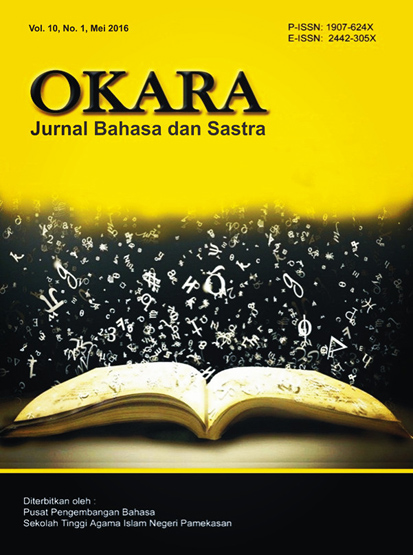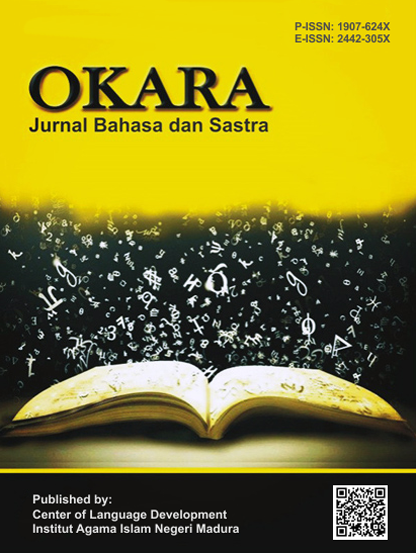THE DIFFICULTIES OF BILINGUALISM (ENGLISH AND ARABIC) ON SPEAKING ABILITY FACED BY THE MEMBERS AT THE FIRST SEMESTER AT APK (ASRAMA PUTERI KHADIJAH)
 Abstract views: 489
,
Abstract views: 489
,
 PDF downloads: 342
PDF downloads: 342
Abstract
The phenomenon of bilingualism happens around us. There are some people that acquire more than one language. The competency of using two languages in a communication is called billinguality. Billinguality deals with the language, and speaking is a part of language skills. APK (Asrama Puteri Khadijah) is a dormitory for college students of STAIN Pamekasan in which the members are required to speak using two languages (English and Arabic) in their daily activities. The problem raises, the members have some difficulties in keeping speaking English and Arabic in balance. Therefore, investigating the process of how the members of APK (Asrama Puteri Khadijah) speak bilingual, some difficulties for them to speak bilingual, and the strength and weaknesses of bilingualism for them are the focus of this study. A descriptive qualitative research is applied in this study. The three data collection procedures that were applied are observation, interview, and documentation. This study results that the process of bilingualism of the members of APK deepens on the concept of grammar understanding in English and Arabic Intensive class, memorizing vocabulary, Muhādhoroh program (formal situation), and how the members practice speaking English and Arabic in their daily communication. Some members used code switching, code mixing, and inference to solve their bilinguality problems on speaking. Furthermore, despite some problems, their mistakes of bilinguality is still understandable and communicative, however, the problems on the morphological, phonological, and syntactical levels are still unresolved.
Downloads
References
Alheyasi, Wallayah. Impact of Bilingual Education Approach to ELL Instruction. A Research Proposal, University of Michigan- Dearborn, 2010.
Alwasilah, A. Chaedar. Pengantar Sosiologi Bahasa. Bandung: Penerbit Angkasa, 1993.
Ary, Donald., Lucy Cheser Jacobs, Chris Sorensen and Asghar Razavieh. Introduction to Research in Education. Canada: WADSWORTH CENGANGE learning, 2006.
Bialyston, Ellen. Bilingualism in Development. Australia: Cambridge University Press, 2003.
Buna’i. Penelitian Qualitatif. Pamekasan: STAIN Pamekasan, 2008.
Cenoz, Jasone and Fred Genesse. Trends in Bilingual Acquisation. IASCL, 1984.
Creswell, John W.. Educational Research :Planning, Conducting, and Evaluating Quantitative And Qualitative Research. Boston: Pearson Education, 2012.
Hamers, Josiane and Michel H. A. Blanc. Bilinguality and Bilingualism: Second edition. United Kingdom: Cambridge University Press, 2004.
Harris, David P. Testing English As a Second Language. United Stated of America: McGraw-Hill, 1969.
Interview: Uswatun Fitriyah, one of APK members, on Wednesday 1st of April 2015 at 07.18 pm at APK (Asrama Puteri Khadijah).
Jannedy, Stefanie. Language Files. Colombus: Ohio State University Press. 1994.
Khair, Abdul and Leonie Agustina. Sociolinguistik : Perkenalan Awal Jakarta: PT Rineka Cipta, 2004.
Lathif, Mohammad Adnan. Research Method on Language Learning an Introduction. Malang: Universitas Negeri Malang, 2015.
Lucas, Ceil. The Sociolinguistics of Sign Languages. United Kingdom: Cambridge University Press, 2004.
McKay, Sandra Lee, cs., Sociolinguistics and Language Teaching. Cambridge University Press, 1996.
Miles, Matthew B., A. Michael Huberman. Qualitative Data Analysis. London: Sage Publication, 1994.
Mulyadi. Introduction to Linguistics. Pamekasan: STAIN Pamekasan Press, 2009.
Oxford Learner’s Pocket Dictionary. New York: Oxford University Press, 2003.
Rabbianty, Eva Nikmatul. English Teaching and Learning Theories (Selected Chapters) hand out. Pamekasan: STAIN Pamekasan, 2013.
Richard, Jack C. and Theodore S. Rodgers. Approaches and Methods in Language Teaching. United Kingdom: CAMBRIDGE University Press, 1986.
Šolcová, Bc. Petra. Master‟s Diploma Thesis entitled Teaching Speaking Skills. Masaryk University, 2011.
Sundari, Siti. The Implementation of “I am the” Model Technique in Teaching Speaking Ability at Eight Grade of MTs Khairul Ulum Tambelangan. Thesis: STAIN Pamekasan, 2012.
Thornbury, Scott. How to Teach Speaking. England: Pearson Education Limited, 2005.
Tim penyusunan pedoman penulisan karya tulis ilmiah, Pedoman Penulisan Karya Tulis Ilmiah.
Troike, Muriel Saville-. Introducing Second Language Acquisition. New York: Cambridge University Press, 2006.
Wardhaugh, Ronald. An Introduction to Sociolinguistics: Fifth Edition. America: Blackwell Publishing, 2006.
https://uk.answers.yahoo.com,
http://www.ncbi.nlm.nih.gov/pmc/articles/PMC3153788/,
http://en.wikipedia.org/wiki/Code-switching,
http://www.education.com/reference/article/bilingual-acquiring-two-language/,
http://www.creators.com/advice/sylvia-rimm-on-raising-kids/advantages-and-disadvantages-in-bilingual-start.html,
http://rujukanskripsi.blogspot.com/2013/06/definition-of-speaking-skil,
http://rujukanskripsi.blogspot.com/2013/06/definition-of-speaking-skill
http://wikibin.org/articles/micro-linguistics.html
http://www.enotes.com/homework-help/what-difference-between-micro-linguistics-macro348204
The journal operates an Open Access policy under a Creative Commons Attribution-NonCommercial 4.0 International License. Authors who publish with this journal agree to the following terms:
- Authors retain copyright and grant the journal right of first publication with the work simultaneously licensed under a Creative Commons Attribution License that allows others to share the work with an acknowledgement of the work's authorship and initial publication in this journal.
- Authors are able to enter into separate, additional contractual arrangements for the non-exclusive distribution of the journal's published version of the work (e.g., post it to an institutional repository or publish it in a book), with an acknowledgement of its initial publication in this journal.
- Authors are permitted and encouraged to post their work online (e.g., in institutional repositories or on their website) prior to and during the submission process, as it can lead to productive exchanges, as well as earlier and greater citation of published work.





_(1).png)
.png)
.png)
1.png)
.png)
.png)

.png)
_-_Copy_-_Copy.png)





